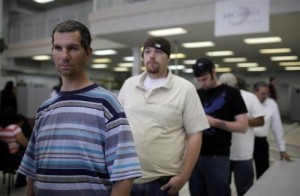 Great essay by Joseph Stiglitz on income inequality: “Of the 1%, by the 1%, for the 1%” in Vanity Fair.
Great essay by Joseph Stiglitz on income inequality: “Of the 1%, by the 1%, for the 1%” in Vanity Fair.
As we gaze out at the popular fervor in the streets [of the Middle East/North Africa], one question to ask ourselves is this: When will it come to America? In important ways, our own country has become like one of these distant, troubled places.
Alexis de Tocqueville once described what he saw as a chief part of the peculiar genius of American society—something he called “self-interest properly understood.” The last two words were the key. Everyone possesses self-interest in a narrow sense: I want what’s good for me right now! Self-interest “properly understood” is different. It means appreciating that paying attention to everyone else’s self-interest—in other words, the common welfare—is in fact a precondition for one’s own ultimate well-being. Tocqueville was not suggesting that there was anything noble or idealistic about this outlook—in fact, he was suggesting the opposite. It was a mark of American pragmatism. Those canny Americans understood a basic fact: looking out for the other guy isn’t just good for the soul—it’s good for business.
The top 1 percent have the best houses, the best educations, the best doctors, and the best lifestyles, but there is one thing that money doesn’t seem to have bought: an understanding that their fate is bound up with how the other 99 percent live. Throughout history, this is something that the top 1 percent eventually do learn. Too late.
Commentators who write on income inequality (the topic has practically gone viral these days) often point out parallels between the US and the Middle East/North Africa. But they quickly say “it won’t happen here,” often citing easy credit in the US. Citizens are (or were) happily buying homes, cars, TVs, and boobs. Sort of a “let them eat cake” attitude.
A recent article at OECD Insights – an organization “committed to … the market economy” – contains links to many recent discussions. It acknowledges that “the trickle-down benefits for lower earners have been fairly weak, and that any benefits have taken a long time to materialise.” (No kidding.) It concludes:
[L]ove it or loathe it, inequality will never vanish entirely, and many believe we would all suffer if it did: The prospect of getting a bit richer is an incentive for entrepreneurs and risk-takers. … [T]he question for societies is more likely to be this: How much inequality are we prepared to live with? Of course, if we decide we’d like a bit less, that raises a second question. As The Economist recently framed it, do we achieve it by pushing up people at the bottom and the middle of the income distribution or by pulling down those at the top?
Is it really either/or? How about both?
Related posts:
Down so low we dare not speak
Breaking the self-destructive meritocratic spell
What Wisconsin hath wrought
Daniel T. Rodgers on equality and inequality
It’s cheaper to let the sick die
Income inequality and American politics
Why the US doesn’t have universal health care
Image: here & now
Resources:
Joseph E. Stiglitz, Of the 1%, by the 1%, for the 1%, Vanity Fair, May 2011
Brian Keeley, High times for the jet-set, OECD Insights, March 14, 2011


Sorry, comments are closed for this post.